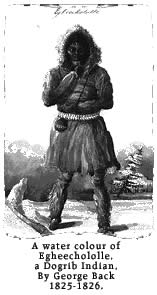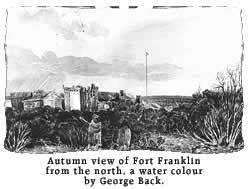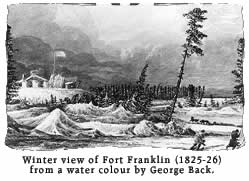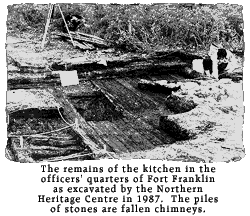
 After
the Napoleonic Wars of the early nineteenth century, Britain's Royal
Navy renewed its efforts to explore the world's oceans for its expanding
commercial trade. A major initiative was the charting of the Northwest
Passage, a navigable route between the Atlantic and Pacific Oceans
through the Canadian Arctic. After
the Napoleonic Wars of the early nineteenth century, Britain's Royal
Navy renewed its efforts to explore the world's oceans for its expanding
commercial trade. A major initiative was the charting of the Northwest
Passage, a navigable route between the Atlantic and Pacific Oceans
through the Canadian Arctic.
Sir John Franklin, on three separate forays, was one
of the central figures in this drama of exploration and scientific
discovery, beginning in 1819. His considerable accomplishments in
mapping vast territories unknown to Europeans are played against
a backdrop of severe suffering and privation.
 It
was on the second expedition that Fort Franklin came into being
as the staging area and winter quarters for a party of nearly fifty
people. Factor Peter Warren Dease of the Hudson's Bay Company selected
one of the most productive Dene fisheries in the Mackenzie River
drainage as the location of the Fort. It was known locally as Dôline
("where the water flows"), on Sahtu (Great Bear Lake),
near the present-day community of the same name. It
was on the second expedition that Fort Franklin came into being
as the staging area and winter quarters for a party of nearly fifty
people. Factor Peter Warren Dease of the Hudson's Bay Company selected
one of the most productive Dene fisheries in the Mackenzie River
drainage as the location of the Fort. It was known locally as Dôline
("where the water flows"), on Sahtu (Great Bear Lake),
near the present-day community of the same name.
 The expedition came into close contact with the Dogrib who wintered
there, and with the Hare-Slavey and Gwich'in who journeyed from
along the north shore of Sahtu to trade meat and furs. The meat
trade with the Dene of Great Bear Lake was essential to the expedition's
food supply. Without this exchange, the expedition might well have
faced the privation which had befallen the first. In exchange, Dr.
Richardson, a naval surgeon, provided medical care.
The expedition came into close contact with the Dogrib who wintered
there, and with the Hare-Slavey and Gwich'in who journeyed from
along the north shore of Sahtu to trade meat and furs. The meat
trade with the Dene of Great Bear Lake was essential to the expedition's
food supply. Without this exchange, the expedition might well have
faced the privation which had befallen the first. In exchange, Dr.
Richardson, a naval surgeon, provided medical care.
 Archaeological excavations of the original fort were conducted by
the Prince of Wales Northern Heritage Centre with the cooperation
and assistance of the people of Dôline, in the summer of 1987. The
information from the excavation has led to a fuller understanding
of the role played by the native people of Great Bear Lake in Franklin's
second expedition. Recovery of quantities of beads,
rings, and buttons verify the importance of the trade between the
Dene and Europeans.
Archaeological excavations of the original fort were conducted by
the Prince of Wales Northern Heritage Centre with the cooperation
and assistance of the people of Dôline, in the summer of 1987. The
information from the excavation has led to a fuller understanding
of the role played by the native people of Great Bear Lake in Franklin's
second expedition. Recovery of quantities of beads,
rings, and buttons verify the importance of the trade between the
Dene and Europeans.
There is still much to be learned from this site. Its fragile
remains are protected from any disturbance by the Northwest
Territories Archaeological Sites Regulations.
|
 After
the Napoleonic Wars of the early nineteenth century, Britain's Royal
Navy renewed its efforts to explore the world's oceans for its expanding
commercial trade. A major initiative was the charting of the Northwest
Passage, a navigable route between the Atlantic and Pacific Oceans
through the Canadian Arctic.
After
the Napoleonic Wars of the early nineteenth century, Britain's Royal
Navy renewed its efforts to explore the world's oceans for its expanding
commercial trade. A major initiative was the charting of the Northwest
Passage, a navigable route between the Atlantic and Pacific Oceans
through the Canadian Arctic.  It
was on the second expedition that Fort Franklin came into being
as the staging area and winter quarters for a party of nearly fifty
people. Factor Peter Warren Dease of the Hudson's Bay Company selected
one of the most productive Dene fisheries in the Mackenzie River
drainage as the location of the Fort. It was known locally as Dôline
("where the water flows"), on Sahtu (Great Bear Lake),
near the present-day community of the same name.
It
was on the second expedition that Fort Franklin came into being
as the staging area and winter quarters for a party of nearly fifty
people. Factor Peter Warren Dease of the Hudson's Bay Company selected
one of the most productive Dene fisheries in the Mackenzie River
drainage as the location of the Fort. It was known locally as Dôline
("where the water flows"), on Sahtu (Great Bear Lake),
near the present-day community of the same name.  The expedition came into close contact with the Dogrib who wintered
there, and with the Hare-Slavey and Gwich'in who journeyed from
along the north shore of Sahtu to trade meat and furs. The meat
trade with the Dene of Great Bear Lake was essential to the expedition's
food supply. Without this exchange, the expedition might well have
faced the privation which had befallen the first. In exchange, Dr.
Richardson, a naval surgeon, provided medical care.
The expedition came into close contact with the Dogrib who wintered
there, and with the Hare-Slavey and Gwich'in who journeyed from
along the north shore of Sahtu to trade meat and furs. The meat
trade with the Dene of Great Bear Lake was essential to the expedition's
food supply. Without this exchange, the expedition might well have
faced the privation which had befallen the first. In exchange, Dr.
Richardson, a naval surgeon, provided medical care.  Archaeological excavations of the original fort were conducted by
the Prince of Wales Northern Heritage Centre with the cooperation
and assistance of the people of Dôline, in the summer of 1987. The
information from the excavation has led to a fuller understanding
of the role played by the native people of Great Bear Lake in Franklin's
second expedition. Recovery of quantities of
Archaeological excavations of the original fort were conducted by
the Prince of Wales Northern Heritage Centre with the cooperation
and assistance of the people of Dôline, in the summer of 1987. The
information from the excavation has led to a fuller understanding
of the role played by the native people of Great Bear Lake in Franklin's
second expedition. Recovery of quantities of